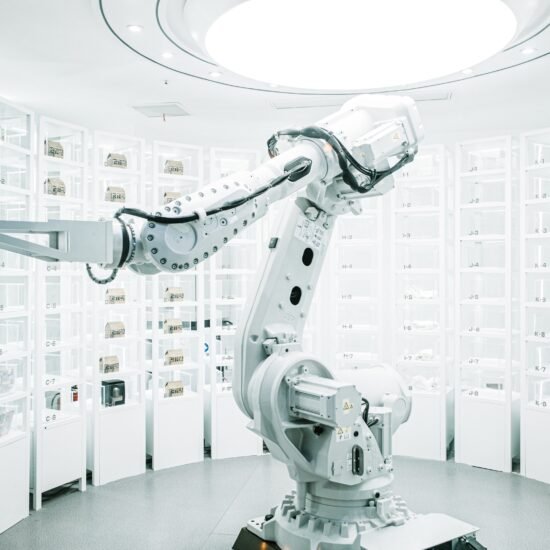The Power of AI in the Workplace
In today’s rapidly evolving work landscape, the integration of AI technology is revolutionizing how we approach our jobs. AI, or Artificial Intelligence, is a powerful tool that has the potential to significantly enhance job efficiency and productivity. In this section, we will provide an introduction to AI technology and explore how it is transforming the job landscape.
Introduction to AI Technology
AI refers to the simulation of human intelligence in machines that are programmed to perform tasks that typically require human intelligence. These tasks can range from simple and repetitive to complex and analytical. AI technology encompasses a wide range of capabilities, including natural language processing, machine learning, and robotics.
One of the key characteristics of AI is its ability to learn and adapt from experience. Machine learning algorithms allow AI systems to analyze vast amounts of data, identify patterns, and make predictions or decisions based on that analysis. This capability enables AI to continuously improve its performance and accuracy over time.
How AI is Transforming the Job Landscape
The rise of AI technology is reshaping the job landscape in various ways. By automating repetitive tasks, AI frees up valuable time and resources, allowing workers to focus on more complex and strategic responsibilities. This not only increases job efficiency but also enables individuals to explore new opportunities for growth and innovation.
AI also plays a crucial role in streamlining decision-making processes. With its ability to process and analyze large volumes of data at high speed, AI systems can provide valuable insights and support in making informed decisions. From predictive analytics to recommendation systems, AI empowers workers to make data-driven decisions, leading to improved outcomes and efficiency.
Moreover, AI enhances productivity and accuracy by reducing human error. AI-powered tools and technologies can perform tasks with precision and consistency, minimizing the risk of mistakes. This is particularly beneficial in industries that require high levels of accuracy, such as healthcare, finance, and manufacturing.
As AI continues to advance, its impact on the job landscape will only grow. It is essential for workers to embrace AI technology and harness its capabilities to stay competitive and thrive in this evolving environment. By leveraging AI tools and technologies, individuals can unlock new levels of efficiency and effectiveness in their professional endeavors.
In the following sections, we will delve deeper into specific AI tools and technologies that can help you achieve job success. We will explore natural language processing (NLP), machine learning algorithms, and robotic process automation (RPA). Stay tuned to discover how these AI-powered solutions can revolutionize the way you work.
Harnessing AI for Job Efficiency
To leverage the power of AI technology and enhance job efficiency, it’s essential to understand how AI can automate tasks, streamline decision-making processes, and enhance productivity and accuracy in the workplace.
Automating Repetitive Tasks
One of the primary benefits of AI technology is its ability to automate repetitive tasks. By utilizing AI-powered tools and systems, you can offload time-consuming and mundane tasks, freeing up valuable time to focus on more complex and strategic aspects of your job.
AI can automate various tasks such as data entry, report generation, email filtering, and customer support. These automated processes not only save time but also reduce the likelihood of human errors, leading to improved accuracy and efficiency.
Streamlining Decision-Making Processes
AI technology can also streamline decision-making processes by providing valuable insights and data analysis. AI-powered algorithms can process vast amounts of data and identify patterns, trends, and correlations that would be challenging for humans to detect.
By leveraging AI tools like natural language processing (NLP) and machine learning algorithms, you can extract valuable information from unstructured data sources such as text documents, emails, and social media posts. This enables you to make data-driven decisions and optimize your workflow.
Enhancing Productivity and Accuracy
Another significant advantage of AI technology is its potential to enhance overall productivity and accuracy in the workplace. AI-powered systems can handle complex computations, perform advanced calculations, and execute tasks with speed and precision.
For example, robotic process automation (RPA) can automate workflows by mimicking human interactions with software systems. This allows for efficient and error-free execution of tasks that require interaction with multiple applications or systems.
By harnessing AI’s capability to handle repetitive tasks, streamline decision-making, and improve accuracy, you can significantly enhance your job efficiency and effectiveness.
To explore specific AI tools and technologies that can assist with job efficiency, continue reading our article on ai tools for job automation. Additionally, learn how AI can assist you further in our article on ai-powered job assistance.
Remember, implementing AI in your work routine requires careful assessment of your job tasks, identifying AI opportunities, and addressing any challenges or concerns that may arise along the way. Embrace the power of AI as a tool to support your work, collaborate effectively with AI systems, and adapt to the changing work environment for continued success.
AI Tools and Technologies for Job Success
To unlock efficiency and achieve job success in today’s AI-driven world, it is essential to harness the power of AI tools and technologies. These cutting-edge advancements can revolutionize the way we work, enabling us to streamline tasks, make informed decisions, and enhance productivity. In this section, we will explore three key AI tools and technologies that can contribute to your job success: Natural Language Processing (NLP), Machine Learning Algorithms, and Robotic Process Automation (RPA).
Natural Language Processing (NLP)
Natural Language Processing (NLP) is a subset of AI that focuses on the interaction between computers and human language. It enables machines to understand, interpret, and generate human language in a way that is meaningful and useful. NLP can be harnessed to automate various language-based tasks, such as analyzing customer feedback, processing large volumes of text data, and generating written content.
Through NLP, AI systems can extract valuable insights from unstructured data, such as customer reviews or social media posts, providing valuable information for decision-making processes. Additionally, NLP-powered chatbots and virtual assistants can enhance customer support by understanding and responding to natural language queries. These AI-powered assistants can handle routine customer inquiries, freeing up valuable time for human employees to focus on more complex tasks.
Machine Learning Algorithms
Machine Learning (ML) algorithms are at the core of AI systems, enabling machines to learn from data and improve their performance over time. These algorithms analyze large datasets, identify patterns, and make predictions or decisions based on the data. ML algorithms can be applied to various job tasks, ranging from data analysis and forecasting to image recognition and process optimization.
By leveraging ML algorithms, AI systems can automate repetitive and time-consuming tasks, such as data entry, data analysis, and report generation. This not only saves valuable time but also enhances accuracy and efficiency. ML algorithms can learn from historical data to make predictions, detect anomalies, and provide valuable insights that can inform decision-making processes. The versatility and adaptability of ML algorithms make them valuable tools for job success in a wide range of industries and domains.
Robotic Process Automation (RPA)
Robotic Process Automation (RPA) is an AI technology that enables the automation of repetitive and rule-based tasks. RPA systems mimic human actions by interacting with digital systems and software applications to perform tasks such as data entry, data extraction, and form processing. RPA can significantly reduce human error, improve efficiency, and free up employees to focus on more strategic and value-added activities.
RPA is particularly beneficial for jobs that involve high-volume, repetitive tasks that do not require complex decision-making. By automating these tasks, employees can allocate their time and skills to more creative and critical-thinking activities. RPA systems can seamlessly integrate with existing software applications, making them easily adaptable to various job environments.
By harnessing the power of NLP, ML algorithms, and RPA, you can leverage AI technologies to enhance your job efficiency and achieve greater success in your role. These tools and technologies have the potential to revolutionize the way we work, providing valuable insights, automating tasks, and streamlining processes. Embrace the opportunities that AI presents and stay ahead in the evolving world of work.
Implementing AI in Your Work Routine
To harness the power of AI technology for job efficiency, it’s important to understand how to implement AI in your work routine. This section will guide you through the process, from assessing your job tasks to identifying AI opportunities and overcoming challenges and concerns.
Assessing Your Job Tasks
The first step in implementing AI in your work routine is to assess your job tasks. Take some time to evaluate the various responsibilities and activities you perform on a regular basis. Consider which tasks are repetitive, time-consuming, or require a significant amount of manual effort. These tasks are prime candidates for automation through AI technology.
Create a list or table to document your job tasks, including details such as the frequency, duration, and level of complexity for each task. This assessment will provide a clear overview of the areas where AI can potentially enhance your job efficiency.
| Task | Frequency | Duration | Complexity |
|---|---|---|---|
| Data entry | Daily | 1 hour | Low |
| Report generation | Weekly | 2 hours | Medium |
| Customer inquiries | Daily | 30 minutes | High |
Identifying AI Opportunities
Once you have assessed your job tasks, the next step is to identify AI opportunities. Look for tasks that can be automated or streamlined through AI technology. For example, tasks that involve data analysis, information retrieval, or pattern recognition can often be handled more efficiently by AI systems.
Consider the specific AI tools and technologies that are available in your field or industry. Research how these technologies can be applied to your job tasks to improve efficiency. For more information on AI tools, visit our article on AI tools for job automation.
| Task | AI Opportunity |
|---|---|
| Data entry | Robotic Process Automation (RPA) |
| Report generation | Natural Language Processing (NLP) |
| Customer inquiries | Chatbot with Machine Learning Algorithms |
Overcoming Challenges and Concerns
Implementing AI in your work routine may come with certain challenges and concerns. It’s important to address these proactively to ensure a smooth transition. Some common challenges include resistance to change, fear of job displacement, and the need for additional training to work effectively with AI systems.
To overcome these challenges, it’s crucial to embrace lifelong learning. Stay updated on the latest advancements in AI technology and actively seek opportunities for professional development. Collaborate with AI systems as partners rather than replacements, leveraging their capabilities to enhance your own skills and productivity. Remember that AI technology is designed to assist and augment human work, not replace it.
As the work environment continues to evolve, adaptability is key. Be open to change and embrace new ways of working that incorporate AI technology. By continually improving your skills and leveraging the power of AI, you can unlock new levels of efficiency and success in your job.
In the next section, we will explore the importance of nurturing a successful partnership with AI, including the benefits of lifelong learning, collaborating with AI systems, and adapting to the changing work environment.
Nurturing a Successful Partnership with AI
To fully harness the power of AI technology and ensure job success, it is important to establish a strong partnership with AI systems. This section will explore three key aspects of nurturing this partnership: embracing lifelong learning, collaborating with AI systems, and adapting to the changing work environment.
Embracing Lifelong Learning
In an AI-driven world, embracing lifelong learning is crucial for job success. AI technology is constantly evolving, and staying up-to-date with the latest advancements is essential to leverage its full potential. By investing time and effort into continuous learning, you can enhance your understanding of AI systems and develop the skills needed to effectively collaborate with them.
Resources such as online courses, webinars, and industry publications can help you expand your knowledge of AI technology. Additionally, staying connected with professional networks and attending conferences or workshops related to AI can provide valuable insights and opportunities for growth. By embracing lifelong learning, you can adapt to the ever-changing landscape of AI and position yourself for success.
Collaborating with AI Systems
Collaboration between humans and AI systems is a key element in achieving job efficiency. AI technology excels in tasks that require data processing, pattern recognition, and repetitive operations. By offloading these tasks to AI systems, you can free up time and mental energy to focus on more complex and creative aspects of your job.
To effectively collaborate with AI systems, it is important to understand their strengths and limitations. This knowledge will enable you to identify tasks that can be automated or optimized using AI tools. Regularly communicate with AI systems to provide feedback and fine-tune their performance. By working synergistically with AI, you can enhance your productivity and achieve better outcomes.
Adapting to the Changing Work Environment
The integration of AI technology brings about changes in the work environment. As AI systems become more prevalent, job roles and responsibilities may evolve. It is crucial to adapt to these changes and embrace the new dynamics of the workplace.
Stay proactive by actively seeking opportunities to incorporate AI technology into your job tasks. Assess your current job responsibilities and identify areas where AI can enhance efficiency and productivity. Keep an open mind and be willing to explore new ways of working that align with the capabilities of AI systems.
Additionally, be receptive to the changing work environment as AI technology continues to advance. Adaptability and flexibility are key traits that will enable you to thrive in a rapidly evolving landscape. Continuously evaluate your skills and knowledge to ensure they remain relevant in an AI-driven world.
By nurturing a successful partnership with AI through lifelong learning, effective collaboration, and adaptability, you can unlock the full potential of AI technology and achieve job success. Embrace the opportunities that AI presents and proactively position yourself for a future where human-AI collaboration is the foundation for professional growth and efficiency.



